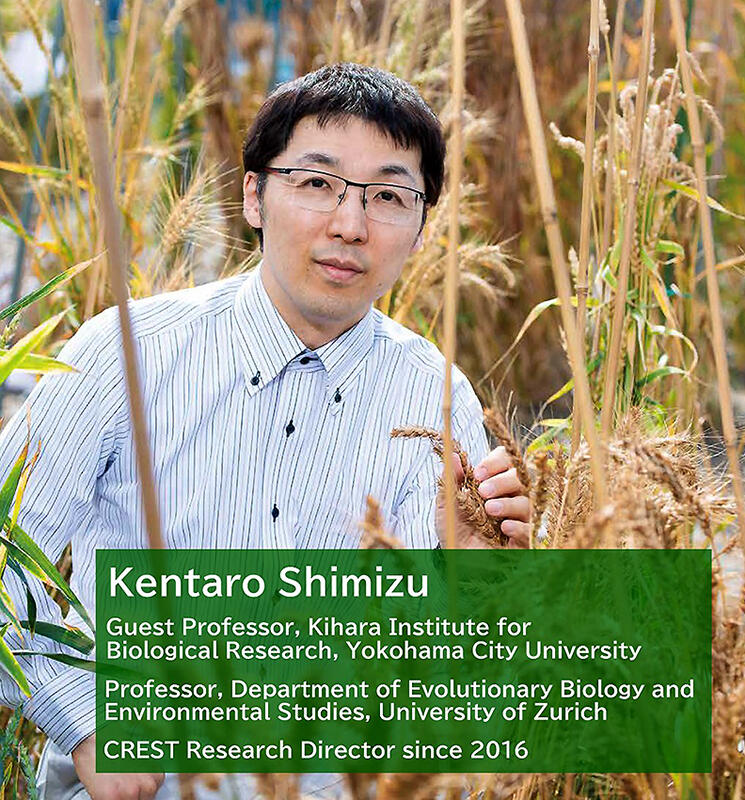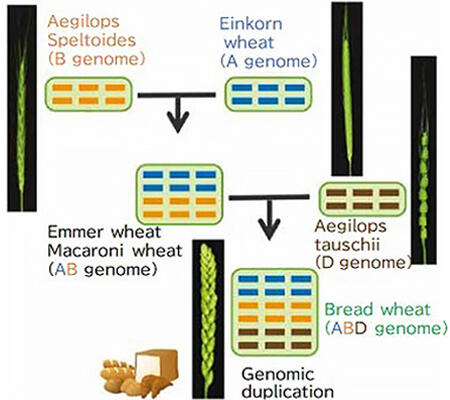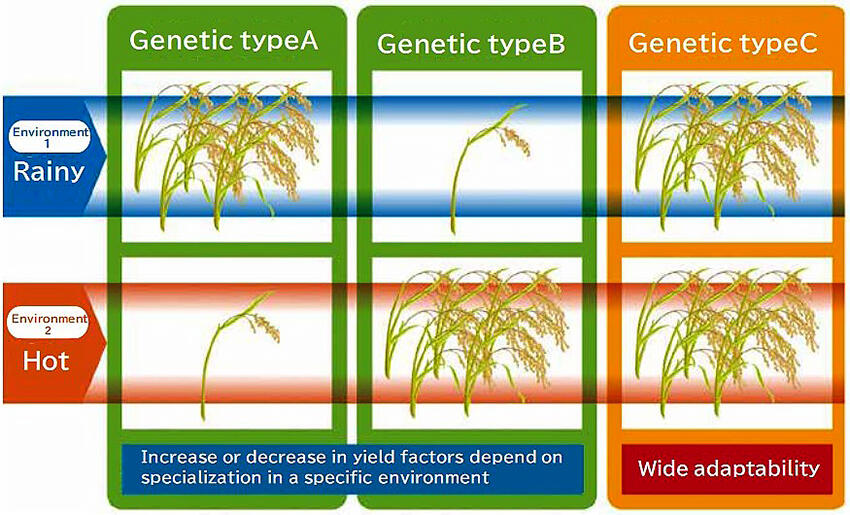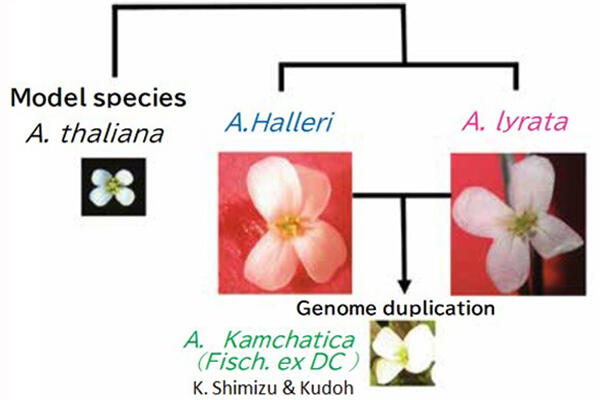Wheat is one of the three most important cereals of the world, along with corn and rice. In Japan, it is second only to rice in terms of consumption. Kentaro Shimizu, Guest Professor at the Kihara Institute for Biological Research, Yokohama City University, aims to ensure a stable supply to meet the increasing demand due to the growing world population. Focusing on the fact that many of the crops are polyploids, which represent a merger of different genomic DNAs, Professor Shimizu continues his search for factors that are resistant to environmental stress.

Genome sequencing conducted as part of international collaboration leads to improved wheat breeds
Wheat is the cereal grain that occupies the most planted area worldwide, and its annual production is estimated around 700 million tons. It is a vital crop with a high protein content, supplying some 20% of the calories consumed by the global population in the form of bread and noodles such as udon. With the world population forecast to reach 10 billion, the world requires higher production and a steady supply of wheat that comprises the basis for food staples. Meanwhile, given the major yield reductions in the wheat crop in some recent years due to global warming, it is necessary to develop varieties that will ensure stable harvests.
In November 2020, the 10+ Wheat Genomes Project, an international collaborative research consortium of 10 countries, achieved the sequencing of 15 cultivars of bread wheat grown around the world. The researcher responsible for the sequencing of the Japanese cultivar Norin 61 was the Guest Professor Kentaro Shimizu at the Kihara Institute for Biological Research, Yokohama City University.
A genome is all the genetic information inherited from the parents. The human genome is diploid, meaning that each cell contains two sets of chromosomes, but many of the plants are polyploids that have cells of more than two sets of chromosomes. Bread wheat is one such example, where three diploid species are crossed to generate hexaploids (Fig. 1). Professor Shimizu outlines the challenge: "It was very hard to sequence the wheat genome due to the high amount of information and the sequence similarity. We were finally able to assemble its genome thanks to the accelerated processing speed of computers and dramatic advances in analysis algorithms in recent years."

Many useful plants are allopolyploids that inherit genomes from different parents. Examples include Arabica coffee, cotton and soybeans. Professor Shimizu explains that his goal "is to help create breeds that are resistant to environmental changes, by using the genomic information of the existing wheat species already analyzed to figure out the mechanism by which allopolyploid plants integrate the environmental responses of their parents"(Fig. 2).

An encounter with Arabidopsis kamchatica put Shimizu on the path to researching allopolyploids
Professor Shimizu's first encounter with allopolyploids was all the way back in his graduate student days. At that time, genomic sequencing of the Arabidopsis thaliana, the well-known model species, was proceeding rapidly and, he recalls, "I wanted to know the molecular mechanism of Arabidopsis thaliana and the molecular background for the diversity of plant species, so I was looking for the wild species that was taxonomically close to it." Professor Shimizu was analyzing the sequence of Arabidopsis kamchatica when he realized it was an allopolyploid. Having identified both parental species, it turned out Arabidopsis kamchatica had a wider distribution in terms of both latitude and altitude than its parents (Fig. 3).

Next, Professor Shimizu established a method to analyze the DNA sequences of polyploids to a much higher degree of precision than previously, then set about unravelling the environmentally responsive genes of the Arabidopsis kamchatica species. Since one parent had high levels of gene expression responsive to heavy metals and resistance, he applied heavy metal treatment to the Arabidopsis kamchatica and found that it had inherited high expression and resistance. Professor Shimizu also found that low temperature resistance was also inherited from the other parent. "In 1% of the entire genome, or around 200 genes, duplicated gene copies from two parents displayed inherited different expression patterns. This should also be related to the resistance in polyploid." Professor Shimizu found similar results when he tested its responses to drought and submersion in water. He hypothesized that allopolyploids had become able to cope with broader environmental stress by combining a relatively small number of genes. Twenty years on, this has become established knowledge and technique, and A. kamchatica is now widely used as a model polyploid.
Collecting information to create new knowledge: a "second green revolution"
Just as Professor Shimizu was looking for a way to apply his long-standing research on allopolyploids to improve wheat breeding, his research project was selected for the CREST funding program in the discipline focusing on plant species that are able to adapt to climate change. At around the same time, he learned that the 10+ Wheat Genomes Project was being planned with the aim to conduct genome variation analysis on wheat, but at that stage, Japan was not involved in the consortium. Through the connections from his concurrently held position as professor at the University of Zurich, Switzerland, and in view of the contribution of the Japanese wheat cultivar to the "green revolution," which achieved the dramatic increase in bread wheat crop yields around the world (the 1970 Nobel Peace Prize), a large number of Japanese researchers later joined the project to sequence Japanese wheat.
Under this international project, Professor Shimizu and his team assembled and analyzed the genome sequence of Norin 61, Japan's leading wheat breed. They found that the number of FT1 genes, which are related to the plant hormone called florigen that promotes flowering, was increasing. The increased number of gene copies is known to be important in individual variation among human beings, but without high-quality genomic data, it is very hard to discover them. The timing of flowering is susceptible to climate change. Climate change has already affected yields, and there is concern that the situation might become more serious. As wheat dislikes humidity, wheat in Japan must be harvested before the wet season, when disease frequently strikes. Therefore, controlling the period of cultivation is an important breeding goal in Japan. It is expected that the newly discovered genomic information will accelerate the improvement of a breed that is robust to climate change.
Sequencing the world's commercial breeds has advanced the understanding of disease-resistant genes and other agriculturally important genes. Professor Shimizu explains the significance of the international project: "The genome of a single cultivar breed may not give many insights. However, if we are able to sequence 1,000 cultivars, it will lead to the improvement of existing breeds via isolation of useful mutations for example. Now is the time for a 'second green revolution'."
Multifaceted evaluation in real environments - Aiming to support healthy diets
It is often the case that a plant grows healthily in the lab, but is challenged by unexpected changes outdoors. Assuming that climate change will be more severe in the future, machine learning is being applied to data obtained from experimental crops in research labs in Japan and overseas. Based on the outcome of this machine learning, a model to predict how different breeds will grow under various conditions is currently under development.
While Professor Shimizu has only just begun his journey to improve wheat breeding, not a day goes by that he does not think about those people suffering from hunger around the world. "Scientific research is often seen as something that will make society richer and more convenient. However, the research we are doing will really come to the fore only when a crisis occurs. Our goal is to make sure that such a day never comes, by continuing to support the conditions for a plentiful food environment in which everyone can naturally eat, under the radar," states Shimizu firmly.




